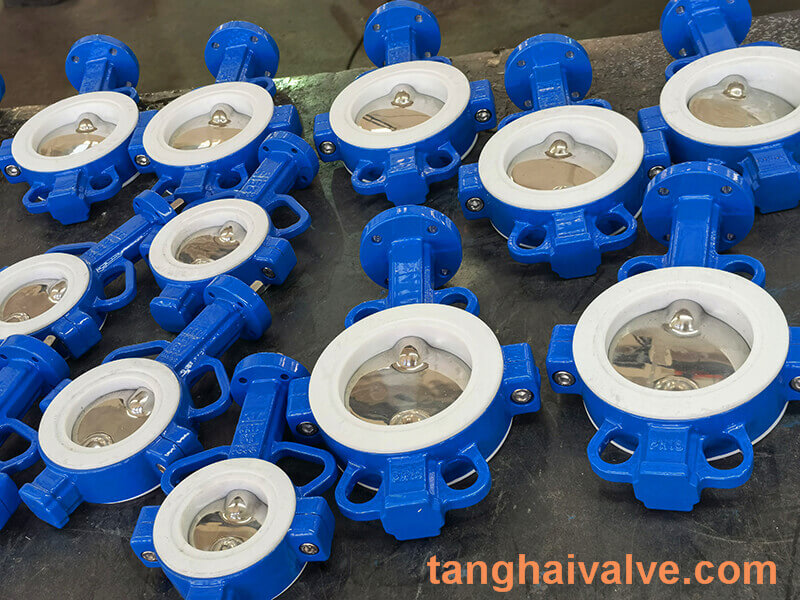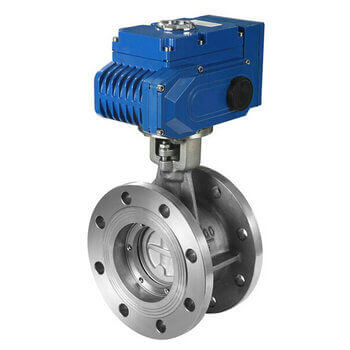electric fluorine-lined butterfly valve vs electric metal seated butterfly valve
The difference between electric fluorine-lined butterfly valve and electric hard seal butterfly valve
Electric butterfly valve is one of the most commonly used valves in industrial pipelines in recent years. In addition to ordinary opening and closing, it can also be used to adjust and control the pressure, flow, temperature and other parameters of various water, liquid, gas and other fluids. An important execution unit in the field of automation control, is widely used in chemical, electric power, petroleum, metallurgy, steam, environmental protection, fire-fighting systems and other occasions! In addition, there are many types of electric butterfly valves and various control modes, which can meet the requirements of various working conditions!

Fluorine lined butterfly valve-PTFE-WAFER (10)
Electric fluorine-lined butterfly valves and electric hard-sealed butterfly valves are the two most commonly used types of butterfly valves. The applicable medium and pressure temperature are completely different! But many people’s choice between the two often seems a bit uncertain! In the simplest terms, the two control modes are the same, the difference is the sealed structure. The electric fluorine-lined butterfly valve is suitable for corrosive media, but it can only be used at room temperature and pressure. The electric hard seal butterfly valve can be used for various pressures. temperature range! The detailed differences are as follows:
Electric fluorine-lined butterfly valve Electric hard-sealed butterfly valve
1. From the structure:
The hard sealing butterfly valve refers to that both sides of the sealing pair are made of metal materials or other harder materials. For soft sealing butterfly valves, the two contacting sealing surfaces can be separate or all of soft materials. For example, fluorine-lined butterfly valve means that the butterfly plate and valve seat are both wrapped in PTFE;

D943H-16C-metal seated stainless steel electric triple offset butterfly valve
2. From the sealing performance:
The advantage of soft-sealed fluorine-lined butterfly valve is good sealing performance, but the disadvantage is that it is easy to age, wear, and has a short service life. The hard seal butterfly valve has a long service life, but the sealing performance is relatively worse than that of the soft seal.
3. From the conditions of use:
The soft-sealed fluorine-lined butterfly valve is used in normal temperature and pressure environment, and the hard-sealed butterfly valve can be used in low temperature, normal temperature, high temperature and other environments. Generally, it can be used for higher pressure, but the soft seal is not. However, the fluorine-lined butterfly valve has super corrosion resistance!
4. From the manufacturing point of view:
As for manufacturing, from a principle point of view, there is little difference between the two, mainly the difference in valve seats. The soft-seal fluorine-lined butterfly valve is a non-metallic structure, and the hard-seal butterfly valve is a metal structure. The hardness relationship between metals and the workmanship must be considered. Situation, what medium to go and so on.
Related knowledge: Working principle diagram of electric butterfly valve Selection of electric wafer butterfly valve and flange butterfly valve
TH Valve is a professional manufacturer of butterfly valve, gate valve, check valve, globe valve, knife gate valve, ball valve with API, JIS, DIN standard, used in Oil, Gas, Marine industry, Water supply and drainage, fire fighting, shipbuilding, water treatment and other systems, with Nominal Diameter of DN50 to DN1200, NBR/EPDM/VITON, Certificates & Approvals: DNV-GL, Lloyds, DNV, BV, API, ABS, CCS. Standards: EN 593, API609, API
Related news /knowledge: Classification and selection of fluorine-lined valves; Selection and application of eccentric butterfly valve; Fluorine-lined valve instructions | Installation instructions;



 © Copyright 2020 Tianjin Tanghaidongyang Valve Co., Ltd. All Rights Reserved.
© Copyright 2020 Tianjin Tanghaidongyang Valve Co., Ltd. All Rights Reserved.